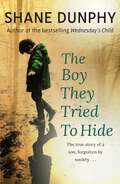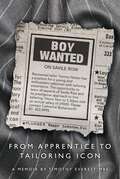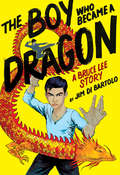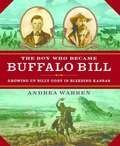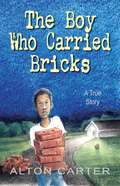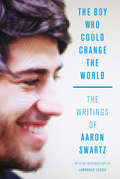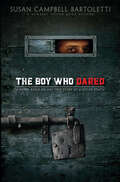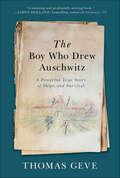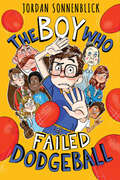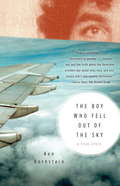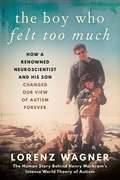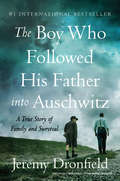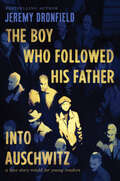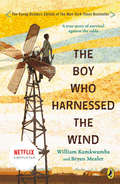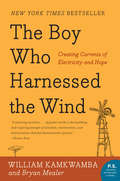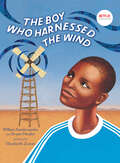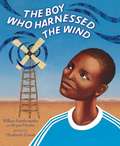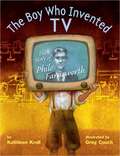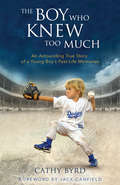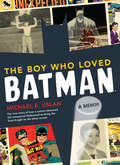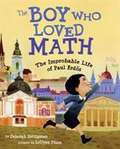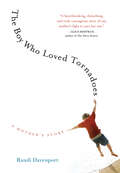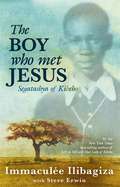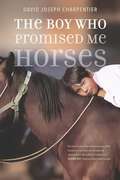- Table View
- List View
The Boy They Tried to Hide: The true story of a son, forgotten by society
by Shane DunphyThe Boy They Tried to Hide is the startling, true account of how truth is sometimes stranger than fiction ...Shane Dunphy was working as a resource teacher in a rural town when he was approached by the mother of one of his pupils, seeking help. She is worried for her troubled young son, who has been found leaving the house late at night to go deep into the woods near their home. He has spoken of meetings with a friend, Thomas, but no one else has seen him or knows who he is. As Shane tries to discover what's going on, a sexual predator he helped bring to justice years before reappears. The man is looking to settle a score, and has picked someone close to Shane as his next victim.In The Boy They Tried to Hide, Shane Dunphy revisits cases he encountered during his time as a child protection worker and journalist and, in doing so, once again discovers that leaving the past behind is harder than it seems.
Boy Wanted on Savile Row: From Apprentice to Tailoring Icon
by Timothy EverestThe son of restaurateurs, young Timothy Everest wanted nothing more than to be a racing driver. This was not to be, but little did he know that a job he took at age 17 – as a sales assistant at Hepworths in Milford Haven – would set the trajectory for success to come.Boy Wanted on Savile Row is the remarkable story of Everest’s meteoric rise in the British fashion industry. Starting in the 1980s and studying under Tommy Nutter, the rebel of Savile Row, while rubbing shoulders with the likes of Steve Strange and Boy George, he branched out on his own the following decade. Here he initially styled bands and pop stars, before spearheading the ‘Cool Britannia’ generation and becoming the face of the New Bespoke Movement. After earning over 3,500 clients, including Tom Cruise, David Beckham and Jay-Z, to name but a few, Everest turned his hand to tailoring for film, creating some truly iconic pieces for such franchises as James Bond and Mission Impossible.In this revealing memoir, featuring a wealth of famous names and celebrity anecdotes, Timothy Everest details the evolution of British tailoring that has shaped the way we view and buy our clothes.
The Boy Who Became a Dragon: A Biography of Bruce Lee
by Jim Di BartoloBruce Lee was born on November 27, 1940 -- in both the hour and the year of the dragon. Almost immediately, he was plunged into conflict: as a child in Hong Kong as it was invaded and occupied by the Japanese; as the object of discrimination and bullying; and as a teenager grappling against the influence of gangs. As the world knows, Lee found his salvation and calling through kung fu -- first as a student, then as a teacher, and finally as a global star. The Boy Who Became a Dragon tells his story in brilliant comic form.
The Boy Who Became Buffalo Bill: Growing Up Billy Cody In Bleeding Kansas
by Andrea WarrenThe greatest entertainer of his era, Buffalo Bill was the founder and star of the legendary show that featured cowboys, Indians, trick riding, and sharpshooters. But long before stardom, Buffalo Bill—born Billy Cody—had to grow up fast. While homesteading in Kansas just before the Civil War, his family was caught up in the conflict with neighboring Missouri over whether Kansas would enter the Union as a free or slave state. To support his family after a pro-slaver killed his father, Billy—then eleven—herded cattle, worked on wagon trains, and rode the Pony Express. As the violence in Bleeding Kansas escalated, he joined the infamous Jayhawkers, seeking revenge on Missourians, and then became a soldier, scout, and spy in the Civil War—all by age seventeen. Award-winning author Andrea Warren brings to life the compelling childhood of an adventurous, determined boy who transformed himself into a true American icon.
The Boy Who Carried Bricks
by Alton CarterAbandoned by his father, neglected by his mother, shuttled between foster homes and a boys ranch for most of his formative years, a young man refuses to succumb to the fate that the world says should be his. Early on, Alton decides he wants a "normal life"--even if that means standing up to abusive relatives and being teased by his siblings and cousins. Along the way, he keeps an eye out for those who might help lighten the load, never losing hope that such people exist.
The Boy Who Could Change the World
by Lawrence Lessig Aaron SwartzIn his too-short life, Aaron Swartz reshaped the Internet, questioned our assumptions about intellectual property, and touched all of us in ways that we may not even realize. His tragic suicide in 2013 at the age of twenty-six after being aggressively prosecuted for copyright infringement shocked the nation and the world.Here for the first time in print is revealed the quintessential Aaron Swartz: besides being a technical genius and a passionate activist, he was also an insightful, compelling, and cutting essayist. With a technical understanding of the Internet and of intellectual property law surpassing that of many seasoned professionals, he wrote thoughtfully and humorously about intellectual property, copyright, and the architecture of the Internet. He wrote as well about unexpected topics such as pop culture, politics both electoral and idealistic, dieting, and lifehacking. Including three in-depth and previously unpublished essays about education, governance, and cities,The Boy Who Could Change the World contains the life's work of one of the most original minds of our time.
The Boy Who Dared
by Susan BartolettiA Newbery Honor Book author has written a powerful and gripping novel about a youth in Nazi Germany who tells the truth about Hitler Bartoletti has taken one episode from her Newbery Honor Book, HITLER YOUTH, and fleshed it out into thought-provoking novel. When 16-year-old Helmut Hubner listens to the BBC news on an illegal short-wave radio, he quickly discovers Germany is lying to the people. But when he tries to expose the truth with leaflets, he's tried for treason. Sentenced to death and waiting in a jail cell, Helmut's story emerges in a series of flashbacks that show his growth from a naive child caught up in the patriotism of the times , to a sensitive and mature young man who thinks for himself.
The Boy Who Drew Auschwitz: A Powerful True Story of Hope and Survival
by Thomas GeveAn inspiring true story of hope and survival, this is the testimony of a boy who was imprisoned in Auschwitz, Gross-Rosen and Buchenwald and recorded his experiences through words and color drawings.In June 1943, after long years of hardship and persecution, thirteen-year-old Thomas Geve and his mother were deported to Auschwitz-Birkenau. Separated upon arrival, he was left to fend for himself in the men’s camp of Auschwitz I.During 22 harsh months in three camps, Thomas experienced and witnessed the cruel and inhumane world of Nazi concentration and death camps. Nonetheless, he never gave up the will to live. Miraculously, he survived and was liberated from Buchenwald at the age of fifteen.While still in the camp and too weak to leave, Thomas felt a compelling need to document it all, and drew over eighty drawings, all portrayed in simple yet poignant detail with extraordinary accuracy. He not only shared the infamous scenes, but also the day-to-day events of life in the camps, alongside inmates' manifestations of humanity, support and friendship.To honor his lost friends and the millions of silenced victims of the Holocaust, in the years following the war, Thomas put his story into words. Despite the evil of the camps, his account provides a striking affirmation of life.The Boy Who Drew Auschwitz, accompanied with 56 of his color illustrations, is the unique testimony of young Thomas and his quest for a brighter tomorrow.
The Boy Who Failed Dodgeball
by Jordan SonnenblickSixth grade is the worst... and also the best, as Jordan rides the ups and downs of middle-school life in hilarious fashion.Funny, outrageous things didn’t stop for Jordan Sonnenblick after he left fourth grade. No, in many ways the events detailed to hilarious effect in The Boy Who Failed Show and Tell were but a prelude to sixth grade, a time when Jordan would have to deal with...-- A rival named Jiminy (his real name is Jimmy -- but, hey, he looks like a cricket)-- A stickler English teacher who doesn’t care that all the old, worn copies of Great Expectations smell like puke-- An Evel Knievel obsession-- A first crush on a girl from band-- An assistant principal who brands Jordan a repeat offender... on his first day (If you want to know why, you have to read the book. A tooth is involved.)-- A continued reckoning with both anxiety and asthma-- And more!
The Boy Who Fell Out of the Sky: A True Story
by Ken DornsteinKen Dornstein always looked up to his older brother David. David was handsome, popular and successful with women. He was talented, and had dreams of writing the Great American Novel - dreams his little brother never doubted would come true. David died in the Lockerbie bombing of 1988, aged 25. This memoir begins as the story of Ken's investigation into David's death. But as his obsessive enquiries go on, it becomes the story of David's life, what he meant to Ken - and who he really was. As it moves towards its devastating finale, Ken's account becomes as page-turning as a thriller, and raises the question: how well do we know the people we love?
The Boy Who Felt Too Much: How a Renowned Neuroscientist and His Son Changed Our View of Autism Forever
by Lorenz WagnerAn International Bestseller, the Story behind Henry Markram&’s Breakthrough Theory about Autism, and How a Family&’s Unconditional Love Led to a Scientific Paradigm Shift Henry Markram is the Elon Musk of neuroscience, the man behind the billion-dollar Blue Brain Project to build a supercomputer model of the brain. He has set the goal of decoding all disturbances of the mind within a generation. This quest is personal for him. The driving force behind his grand ambition has been his son Kai, who has autism. Raising Kai made Henry Markram question all that he thought he knew about neuroscience, and then inspired his groundbreaking research that would upend the conventional wisdom about autism, expressed in his now-famous theory of Intense World Syndrome. When Kai was first diagnosed, his father consulted studies and experts. He knew as much about the human brain as almost anyone but still felt as helpless as any parent confronted with this condition in his child. What&’s more, the scientific consensus that autism was a deficit of empathy didn&’t mesh with Markram&’s experience of his son. He became convinced that the disorder, which has seen a 657 percent increase in diagnoses over the past decade, was fundamentally misunderstood. Bringing his world-class research to bear on the problem, he devised a radical new theory of the disorder: People like Kai don&’t feel too little; they feel too much. Their senses are too delicate for this world.
The Boy Who Followed His Father into Auschwitz: A True Story of Family and Survival
by Jeremy Dronfield“Brilliantly written, vivid, a powerful and often uncomfortable true story that deserves to be read and remembered. It beautifully captures the strength of the bond between a father and son.”--Heather Morris, author of #1 New York Times bestseller The Tattooist of AuschwitzThe #1 Sunday Times bestseller—a remarkable story of the heroic and unbreakable bond between a father and son that is as inspirational as The Tattooist of Auschwitz and as mesmerizing as The Choice.Where there is family, there is hopeIn 1939, Gustav Kleinmann, a Jewish upholster from Vienna, and his sixteen-year-old son Fritz are arrested by the Gestapo and sent to Germany. Imprisoned in the Buchenwald concentration camp, they miraculously survive the Nazis’ murderous brutality.Then Gustav learns he is being sent to Auschwitz—and certain death.For Fritz, letting his father go is unthinkable. Desperate to remain together, Fritz makes an incredible choice: he insists he must go too. To the Nazis, one death camp is the same as another, and so the boy is allowed to follow. Throughout the six years of horror they witness and immeasurable suffering they endure as victims of the camps, one constant keeps them alive: their love and hope for the future. Based on the secret diary that Gustav kept as well as meticulous archival research and interviews with members of the Kleinmann family, including Fritz’s younger brother Kurt, sent to the United States at age eleven to escape the war, The Boy Who Followed His Father into Auschwitz is Gustav and Fritz’s story—an extraordinary account of courage, loyalty, survival, and love that is unforgettable.
The Boy Who Followed His Father into Auschwitz: A True Story Retold for Young Readers
by Jeremy DronfieldThis powerful, moving middle grade adaptation of the adult international bestselling narrative nonfiction book The Boy Who Followed His Father into Auschwitz shines a light on the true story of two brothers who experienced the atrocities of the Holocaust in very different ways.Fritz Kleinmann was fourteen when the Nazis took over Vienna. Kurt, his little brother, was eight. Under Hitler’s brutal regime, their Austrian-Jewish family of six was cruelly torn apart.Taken to Buchenwald concentration camp, Fritz and his Papa, Gustav, underwent hard labor and starvation. Meanwhile, Kurt made the difficult voyage, all alone, to America, to escape the war.When Papa was ordered to the infamous Auschwitz concentration camp, Fritz—desperate not to lose his beloved father—insisted he must go too. Together, they endured countless atrocities to survive.Jeremy Dronfield authentically and accurately captures this family tale of bravery, love, hope, and survival with the help of extensive research and primary sources like Gustav’s diary and interviews with family members. Maps, black-and-white photos, a timeline of events, a glossary, and more are included.
The Boy Who Harnessed the Wind: Young Readers Edition (P. S. Series)
by Anna Hymas Bryan Mealer William KamkwambaWhen a terrible drought struck William Kamkwamba's tiny village in Malawi, his family lost all of the season's crops, leaving them with nothing to eat and nothing to sell. William began to explore science books in his village library, looking for a solution. There, he came up with the idea that would change his family's life forever: he could build a windmill. Made out of scrap metal and old bicycle parts, William's windmill brought electricity to his home and helped his family pump the water they needed to farm the land.Retold for a younger audience, this exciting memoir shows how, even in a desperate situation, one boy's brilliant idea can light up the world. Complete with photographs, illustrations, and an epilogue that will bring readers up to date on William's story, this is the perfect edition to read and share with the whole family.
The Boy Who Harnessed the Wind: Creating Currents of Electricity and Hope (P. S. Series)
by William Kamkwamba Bryan Mealer<P>William Kamkwamba was born in Malawi, a country where magic ruled and modern science was mystery. It was also a land withered by drought and hunger, and a place where hope and opportunity were hard to find. <P>But William had read about windmills in a book called Using Energy, and he dreamed of building one that would bring electricity and water to his village and change his life and the lives of those around him. His neighbors may have mocked him and called him misala--crazy--but William was determined to show them what a little grit and ingenuity could do. Enchanted by the workings of electricity as a boy, William had a goal to study science in Malawi's top boarding schools. <P>But in 2002, his country was stricken with a famine that left his family's farm devastated and his parents destitute. Unable to pay the eighty-dollar-a-year tuition for his education, William was forced to drop out and help his family forage for food as thousands across the country starved and died.Yet William refused to let go of his dreams. With nothing more than a fistful of cornmeal in his stomach, a small pile of once-forgotten science textbooks, and an armory of curiosity and determination, he embarked on a daring plan to bring his family a set of luxuries that only two percent of Malawians could afford and what the West considers a necessity -- electricity and running water. <P>Using scrap metal, tractor parts, and bicycle halves, William forged a crude yet operable windmill, an unlikely contraption and small miracle that eventually powered four lights, complete with homemade switches and a circuit breaker made from nails and wire. A second machine turned a water pump that could battle the drought and famine that loomed with every season. <P>Soon, news of William's magetsi a mphepo--his "electric wind"--spread beyond the borders of his home, and the boy who was once called crazy became an inspiration to those around the world. Here is the remarkable story about human inventiveness and its power to overcome crippling adversity. The Boy Who Harnessed the Wind will inspire anyone who doubts the power of one individual's ability to change his community and better the lives of those around him. <P><b>A New York Times Bestseller</b>
The Boy Who Harnessed the Wind: Picture Book Edition
by William Kamkwamba Bryan MealerNow a Netflix film starring and directed by Chiwetel Ejiofor, this is a gripping memoir of survival and perseverance about the heroic young inventor who brought electricity to his Malawian village. When a terrible drought struck William Kamkwamba's tiny village in Malawi, his family lost all of the season's crops, leaving them with nothing to eat and nothing to sell. William began to explore science books in his village library, looking for a solution. There, he came up with the idea that would change his family's life forever: he could build a windmill. Made out of scrap metal and old bicycle parts, William's windmill brought electricity to his home and helped his family pump the water they needed to farm the land. Retold for a younger audience, this exciting memoir shows how, even in a desperate situation, one boy's brilliant idea can light up the world. Complete with photographs, illustrations, and an epilogue that will bring readers up to date on William's story, this is the perfect edition to read and share with the whole family.
The Boy Who Harnessed the Wind: Young Readers Edition
by William Kamkwamba Bryan Mealer Anna HymasNIMAC-sourced textbook
The Boy Who Harnessed The Wind
by William Kamkwamba Bryan Mealer Elizabeth ZunonWhen fourteen-year-old William Kamkwamba's Malawi village was hit by a drought, everyone's crops began to fail. Without enough money for food, let alone school, William spent his days in the library... <P> and figured out how to bring electricity to his village. Persevering against the odds, William built a functioning windmill out of junkyard scraps, and thus became the local hero who harnessed the wind. Lyrically told and gloriously illustrated, this story will inspire many as it shows how - even in the worst of times - a great idea and a lot of hard work can still rock the world.
The Boy Who Invented TV: The Story of Philo Farnsworth
by Kathleen KrullAn inspiring true story of a boy genius. Plowing a potato field in 1920, a 14-year-old farm boy from Idaho saw in the parallel rows of overturned earth a way to "make pictures fly through the air." This boy was not a magician; he was a scientific genius and just eight years later he made his brainstorm in the potato field a reality by transmitting the world's first television image. This fascinating picture-book biography of Philo Farnsworth covers his early interest in machines and electricity, leading up to how he put it all together in one of the greatest inventions of the 20th century. The author's afterword discusses the lawsuit Farnsworth waged and won against RCA when his high school science teacher testified that Philo's invention of television was years before RCA's.
The Boy Who Knew Too Much: An Astounding True Story of a Young Boy's Past-Life Memories
by Cathy Byrd"Mommy, I used to be a tall baseball player.""Yes, you will be a tall baseball player someday."With a look of exasperation, he stomped his foot and hollered."No! I was a tall baseball player —tall like Daddy!"What was my son trying to say to me? Did he mean . . . he couldn’t mean . . . was he trying to tell me that he was a grown-up in a previous lifetime?At the tender age of two, baseball prodigy Christian Haupt began sharing vivid memories of being a baseball player in the 1920s and ’30s. From riding cross-country on trains, to his fierce rivalry with Babe Ruth, Christian described historical facts about the life of American hero and baseball legend Lou Gehrig that he could not have possibly known at the time.Distraught by her son’s uncanny revelations, Christian’s mother, Cathy, embarked on a sacred journey of discovery that would shake her beliefs to the core and forever change her views on life and death.In this compelling and heartwarming memoir, Cathy Byrd shares her remarkable experiences, the lessons she learned as she searched to find answers to this great mystery, and a story of healing in the lives of these intertwined souls.The Boy Who Knew Too Much will inspire even the greatest skeptics to consider the possibility that love never dies.
The Boy Who Loved Batman: A Memoir
by Michael E. UslanIs any superhero cooler than Batman? He s a crime-fighting vigilante with a tragic past, a lawless attitude, and a seemingly endless supply of high-tech gadgetry. In this fully illustrated memoir, author Michael Uslan recalls his journey from early childhood fandom through to the decades he spent on a caped crusade of his own: to bring Batman to the silver screen as the dark, serious character he was at heart. Uslan's story traces his path from the wilds of New Jersey to the limelight of Hollywood, following his work as Executive Producer on every Batman film from Tim Burton s 1989 re-envisioning to 2012's The Dark Knight Rises. Through it all, he helped to create one of the most successful pop culture franchises of all time.
The Boy Who Loved Math: The Improbable Life of Paul Erdos
by Deborah HeiligmanMost people think of mathematicians as solitary, working away in isolation. And, it's true, many of them do. But Paul Erdos never followed the usual path. At the age of four, he could ask you when you were born and then calculate the number of seconds you had been alive in his head. But he didn't learn to butter his own bread until he turned twenty. Instead, he traveled around the world, from one mathematician to the next, collaborating on an astonishing number of publications. With a simple, lyrical text and richly layered illustrations, this is a beautiful introduction to the world of math and a fascinating look at the unique character traits that made "Uncle Paul" a great man.
The Boy Who Loved Tornadoes: A Mother's Story
by Randi Davenport“A heartbreaking, disturbing, and truly courageous story of one mother’s fight to save her son” (Alice Hoffman, New York Times–bestselling author). Randi Davenport’s young son, Chase, kept having problems, but a diagnosis proved elusive. Some said it was autism, others, ADHD—but as time went by, the problems only increased. She worked hard to provide her family with a sense of stability and strength, but her husband’s erratic behavior only made the situation worse. Eventually, James Davenport slipped into his own world, leaving his wife and kids behind. At fifteen, Chase entered an unremitting psychosis—pursued by terrifying images, unable to recognize his own mother, unwilling to eat or even talk. This is the heartbreaking yet triumphant story of how a single mother navigated the byzantine and broken health care system, and managed to not just save her son from the brink of suicide, but bring him back to her and make her family whole again. The Boy Who Loved Tornadoes is “an unforgettable memoir of a shattered family, a mother’s abiding love, and the frightening permutations of the human mind” (Elle). “A gripping and deeply compelling book about a mother’s search for the proper care and treatment for her psychotic son. Davenport shows us the gritty and enraging reality of our long fractured mental health system . . . The best book I’ve read about mental illness since Kay Jamison’s An Unquiet Mind.” —Virginia Holman, author of Rescuing Patty Hearst: Growing Up Sane in a Decade Gone Mad “A brave and beautiful story by a born writer . . .This book is like a beacon, offering clarity, inspiration, and validation for us all, especially those of us, like myself, who have struggled with serious mental illness in our families.” —Lee Smith, author of Mrs. Darcy and the Blue-Eyed Stranger
The Boy Who Met Jesus: Segatashya of Kibeho
by Immaculée Ilibagiza Steve ErwinIt's the greatest story never told: that of a boy who met Jesus and dared to ask him all the questions that have consumed mankind since the dawn of time. No matter what one's faith or religious beliefs are, Segatashya's words will bring comfort and joy.
The Boy Who Promised Me Horses
by David Joseph Charpentier&“He tried to outrun a train,&” Theodore Blindwoman told David Joseph Charpentier the night they found out about Maurice Prairie Chief&’s death. When Charpentier was a new teacher at St. Labre Indian School in Ashland, Montana, Prairie Chief was the first student he met and the one with whom he formed the closest bonds. From the shock of moving from a bucolic Minnesota college to teach at a small, remote reservation school in eastern Montana, Charpentier details the complex and emotional challenges of Indigenous education in the United States. Although he intended his teaching tenure at St. Labre to be short, Charpentier&’s involvement with the school has extended past thirty years. Unlike many white teachers who came and left the reservation, Charpentier has remained committed to the potentialities of Indigenous education, motivated by the early friendship he formed with Prairie Chief, who taught him lessons far and wide, from dealing with buffalo while riding a horse to coping with student dropouts he would never see again. Told through episodic experiences, the story takes a journey back in time as Charpentier searches for answers to Prairie Chief&’s life. As he sits on top of the sledding hill near the cemetery where Prairie Chief is buried, Charpentier finds solace in the memories of their shared (mis)adventures and their mutual respect, hard won through the challenges of educational and cultural mistrust.
